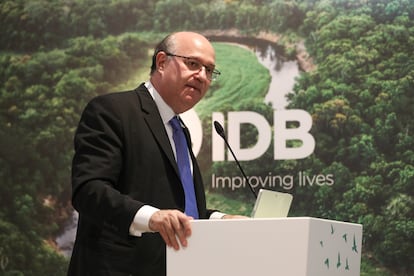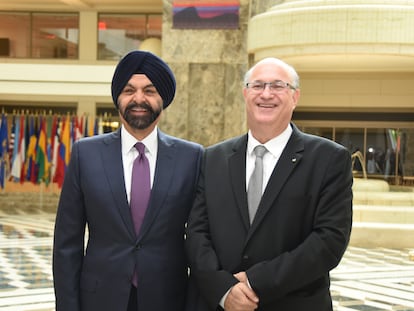Ilan Goldfajn launches into IDB reform after bringing peace and quiet to a tense organization
The president of the regional development institution is hoping that next year’s decisive annual assembly will approve his new strategy based on project impact rather than on loan figures


Ilan Goldfajn is a quiet man who became president of the Inter-American Development Bank (IDB) in November of last year, when it had become a hornet’s nest. The dismissal of the previous president in the midst of a scandal that caused him to lose the trust of the governors left open wounds, grievances and feelings of mistrust. The new president took office with a promise to build bridges. Now that the institution has been pacified and a certain normality has been recovered, Goldfajn’s roadmap is aiming for a thorough reform of the IDB for the period 2024-2030, to increase the effectiveness of its action to promote development.
Goldfajn held a news conference in Washington on Thursday to take stock of the year and present the president’s report, summarizing the achievements of 2023 and the challenges and priorities for the future, and which was presented to the IDB board this Wednesday. A native of Brazil, Goldfajn has experience as a governor of the central bank of Brazil and as a senior manager at the World Bank. He arrived at the IDB with clear ideas about what steps to take, and designed an agenda of reforms; however, most of them must be approved at the assembly scheduled for next year in the Dominican Republic. “Looking back, much has been achieved, but there is still much to do,” he said.
At the news conference, Goldfajn indicated that the Latin America and Caribbean region faces three challenges above all: the social development challenge; the fiscal challenge, with the related problems of public accounts, and the economic challenge posed by a lack of growth. In this context of difficulties, he explained, the institution has set three priorities.
The first is to reduce poverty and inequality, investing in food security, gender equality and inclusion of diverse population groups, social protection and development of human capital (education, health and more). The second involves addressing climate change, including the protection of the Amazon rainforest, the reduction of greenhouse gas emissions, the preservation of nature and biodiversity, and the strengthening of climate resilience and adaptation of countries. And the third is to drive sustainable growth with the aim of significantly increasing the region’s real GDP per capita, in particular through sustainable physical and digital infrastructure, a boost to productivity and innovation, and initiatives to boost regional integration.
To undertake these priorities, the IDB is immersed in a series of institutional and structural reforms, but also working towards a change of culture and the way of measuring achievements. For Goldfajn, what is important is not the amount of dollars lent or the number of projects approved, but the concrete, measurable and large-scale impact that these projects have on people and countries.
Annual balance
Despite this message, in the absence of a better measurement, the IDB continues to make its balance sheet in hard cash. This year, the regional lender approved 92 projects with a sovereign guarantee for a total of $12.7 billion. The approval program included 74 investment projects, for a total of $7.8 billion, and 18 policy reform projects representing $4.9 billion.
By the end of 2023, the IDB plans to disburse around $10 billion for sovereign guaranteed projects. This amount is 6% lower than that disbursed in 2022, but 10% higher than the annual average for the period before the pandemic (2016-2019).
IDB Invest, the private sector arm of the IDB Group, met its operational goals, according to Goldfajn. Total commitments, including its own account and mobilizations, reached an estimated $10 billion at the end of the year.
Regarding the change in the internal environment, Goldfajn maintains: “For me it was a professional and personal priority to enhance dialogue and build bridges in the Bank. Therefore, it was natural to listen more to our employees, and the message was clear: they wanted a healthy work culture in which divergent opinions can be expressed, where respect and fairness prevail, and where merit and innovation are rewarded.” The president of the IDB asserted that transparency and meritocracy in hiring has improved. It has also returned to more in-person work.
“Our new orientation towards effectiveness and development results also requires a cultural transformation at the Bank. Promoting a culture of impact, rather than borrowed amounts, requires changing incentives and processes: a global transformation. Next year will be important to advance the changes that will help us achieve this goal,” he said.
In the near future, the IDB’s next milestone is the 2024 Annual Meeting. “Our work in the coming years will be largely defined by the decisions our governors make,” said Goldfajn. “If the new Institutional Strategy is approved, we will begin the detailed design and implementation of the entire set of reforms. If our governors approve the plans for IDB Invest 2.0 and its capitalization, as well as the proposed replenishment of resources for IDB Lab, next year will require us to prepare for an IDB Group that is not only larger, but significantly better.”
Sign up for our weekly newsletter to get more English-language news coverage from EL PAÍS USA Edition
Tu suscripción se está usando en otro dispositivo
¿Quieres añadir otro usuario a tu suscripción?
Si continúas leyendo en este dispositivo, no se podrá leer en el otro.
FlechaTu suscripción se está usando en otro dispositivo y solo puedes acceder a EL PAÍS desde un dispositivo a la vez.
Si quieres compartir tu cuenta, cambia tu suscripción a la modalidad Premium, así podrás añadir otro usuario. Cada uno accederá con su propia cuenta de email, lo que os permitirá personalizar vuestra experiencia en EL PAÍS.
¿Tienes una suscripción de empresa? Accede aquí para contratar más cuentas.
En el caso de no saber quién está usando tu cuenta, te recomendamos cambiar tu contraseña aquí.
Si decides continuar compartiendo tu cuenta, este mensaje se mostrará en tu dispositivo y en el de la otra persona que está usando tu cuenta de forma indefinida, afectando a tu experiencia de lectura. Puedes consultar aquí los términos y condiciones de la suscripción digital.
More information
Archived In
Últimas noticias
Most viewed
- Sinaloa Cartel war is taking its toll on Los Chapitos
- Oona Chaplin: ‘I told James Cameron that I was living in a treehouse and starting a permaculture project with a friend’
- Reinhard Genzel, Nobel laureate in physics: ‘One-minute videos will never give you the truth’
- Why the price of coffee has skyrocketed: from Brazilian plantations to specialty coffee houses
- Silver prices are going crazy: This is what’s fueling the rally









































